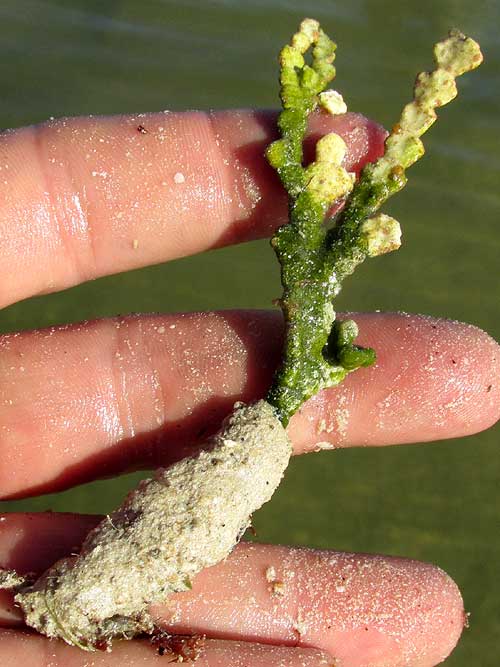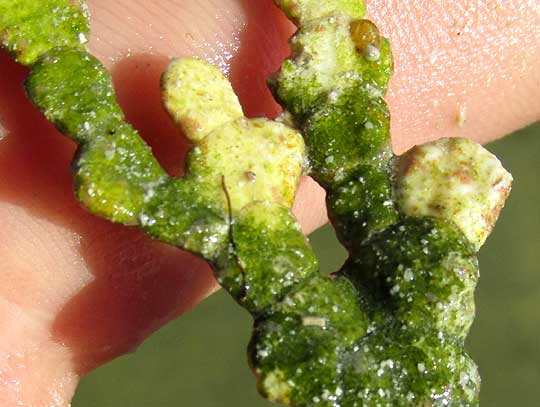Excerpts from Jim Conrad's
Naturalist Newsletter
from the March 1, 2015 Newsletter issued from Río Lagartos, on the Yucatan Peninsula's northern coast (~N21.60°, ~W88.16°), Yucatán state, MÉXICO
HALIMEDA INCRASSATA
At low tide as others gawk at flamingos, sometimes you can lean over the boat's edge and pluck from the muddy estuary bottom such nice algae as what's shown below:

A close-up of the upper part is shown below:

The field marks to notice are that the green photosynthesizing segments are flattish, they arise from atop one another on occasionally branching stems, and that there's a basal gob of mud held together by an extensive rootlike network of very fine "rhizoids." Rhizoids are slender, rootlike filaments that issue from an alga, a fungus, or the gametophyte of a moss, liverwort, or fern, and serve to attach the organism to its substrate, and obtain nourishment.
As soon as I saw this alga and felt its hardness, stiffness and dark greenness, I figured it might be in the same family as the stiff, hard, dark green Mermaid's Fan we profiled a month ago. Our Mermaid's Fan also came up with a blob of mud held together at its base by a system of rhizoids. You might enjoy comparing these similarities on our Mermaid's Fan page, at www.backyardnature.net/mexnat/udotea.htm.
Mermaid's Fan belongs to the green alga family Udoteaceae, and the checklist of Udoteaceae for the Ría Lagartos Biosphere Reserve lists four species in that family, one of which looks exactly like the organism in our picture.
And that's HALIMEDA INCRASSATA, reported from tropical waters nearly worldwide. It's a favorite of aquarium keepers because it's pretty, easy to grow, and also because it's so stiff and hard that fish won't eat it. Despite it commonness and familiarity to aquarists, the alga doesn't seem to have a decent common name. I've seen it called Three Finger Leaf but can't see any reason in that, so we'll just use Halimeda incrassata.
Most commonly, Halimeda incrassata is found in shallow, sandy-bottomed waters, including seagrass beds, which is exactly where ours was found, but also sometimes it turns up in sandy, rocky areas on and between reefs.
As with the Mermaid's Fan, the alga's tough body is composed of very many intertwining algal filaments. The filaments lack cell walls, so that cell nuclei, photosynthesizing chloroplasts and other organelles can migrate throughout the plant body. Probably that explains why our specimen has white blotches: Maybe a leaf or something covered part of it, causing its chloroplasts to migrate to parts of the body where more light was available.
Mermaid's Fan, our Halimeda incrassata and other related species are known as "calcareous" algae, which means that they've incorporated the mineral calcium carbonate into their bodies, calcium carbonate being the main ingredient of limestone. Since the entire Yucatan is a big slab of limestone and the estuary's waters are known to contain high levels of dissolved calcium carbonate, that might explain why so many calcareous algae grow in our submerged seagrass prairies.